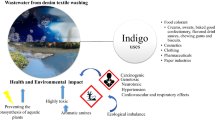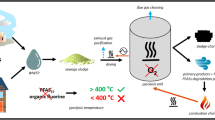Abstract
Degradation of bisphenol A (BPA, 0.5 L, 30 mg L−1) was studied by photo-Fenton treatment, while Fenton reagents were variables. The efficiency of the degradation process was evaluated by the reduction of total organic carbon (TOC), the biochemical oxygen demand (BOD), and toxicity. For toxicity analysis, bacterial methods were found infeasible, but the in vitro assay of VERO cells culture was successfully applied. Experiments according to a 22 design of experiments (DOE) with star points and three center points for statistical validity allowed selecting those process conditions (Fe(II) and H2O2 load) that maximized the process performance. Photo-Fenton process effectively eliminated BPA and partly degraded its by-products (residual TOC <15 %) under substoichiometric H2O2 dose (100.62 mg L−1) and at least 4 mg L−1 Fe(II), after a 90-min treatment. All treated samples were at least partially biodegradable. The cytotoxic concentration (LD50) of BPA for VERO cells was 7 mg L−1. With small H2O2 amount (15.24 mg L−1), only low BPA mineralization (TOC = 92 %) was attained. Toxicity was also detected to 50 % of cellular mortality even at long reaction times. However, 40.25 mg L−1 of H2O2 decreased residual TOC to 70 % while cell mortality decreased down to 25 %. With more H2O2, the residual TOC decreased down to 15 % but cell mortality remained within the 20–25 % level. Photo-Fenton increased the biodegradability and reduced the toxicity of the studied sample.







Similar content being viewed by others
References
Atkinson A, Roy D (1995a) In vitro conversion of environmental estrogenic chemical bisphenol A to DNA binding metabolite(s). Biochem Biophys Res Commun 210:424–433. doi:10.1006/bbrc.1995.1678
Atkinson A, Roy D (1995b) In vivo DNA adduct formation by bisphenol A. Environ Mol Mutagen 26:60–66
Baciocchi R, Boni MR, D’Aprile L (2003) Hydrogen peroxide lifetime as an indicator of the efficiency of 3-chlorophenol Fenton’s and Fenton-like oxidation in soils. J Hazard Mater 96:305–329. doi:10.1016/S0304-3894(02)00218-2
Chiang K, Lim TM, Tsen I, Lee CC (2004) Photocatalytic degradation and mineralization of bisphenol A by TiO2 and platinized TiO2. Appl Catal A Gen 261:225–237. doi:10.1016/j.apcata.2003.11.004
De Lima Perini, J.A., Pérez-Moya M., Pupo Nogueira, R.F. (2013) Photo-Fenton degradation kinetics of low ciprofloxacin concentration using different iron sources and pH, J Photochem Photobiol A Chem 259: 53–58
DOGC núm. 3894, DECRET 130/2003, de 13/05/2003, (29.5.2003). http://www.gencat.cat/diari/3894/03127147.htm, accessed 16/07/2013
EFSA (2015) Scientific opinion on the risks to public health related to the presence of bisphenol A (BPA) in foodstuffs: PART II - toxicological assessment and risk characterisation. EFSA Panel on Food Contact Materials, Enzymes, Flavourings and Processing Aids (CEF). EFSA J 2015 13(1):3978. doi:10.2903/j.efsa.2015.3978
EC (European Communities) (2010) European Union Updated Risk Assessment Report. CAS No:80–05-7. 4,4′-isopropylidenediphenol (bisphenol-A): environment addendum of February 2008. doi: 10.2788/40195
Garcia-Montaño J, Domenech X, Garcia-Hortal JA, Torrades F, Peral J (2006) Combining photo-Fenton process with aerobic sequencing batch reactor for commercial hetero-bireactive dye removal. Appl Catal B Environ 67:86–92. doi:10.1016/j.apcatb.2006.04.007
Huang W (2013) Homogeneous and heterogeneous Fenton and photo-Fenton processes: Impact of iron complexing agent Ethylenediamine-N,N′-disuccinic acid (EDDS). Université Blaise Pascal. Clermong-Ferrand II. 2012.
Ike M, Chen MY, Jin CS, Fujita M (2002) Acute toxicity, mutagenecity, and estrogenicity of biodegradation products of bisphenol A. Environ Toxicol 17:457–461. doi:10.1002/tox.10079
Jiang X, Wu Y, Wang P, Li H, Dong W (2013) Degradation of bisphenol A in aqueous solution by persulfate activated with ferrous ion. Environ Sci Pollut Res Int 20:4947–4953. doi:10.1007/s11356-013-1468-5
Katsumata H, Kawabea S, Kanecoa S, Suzukib T, Ohta K (2004) Degradation of bisphenol A in water by the photo-Fenton reaction. J Photochem Photobiol A Chem 162:297–305. doi:10.1016/S1010-6030(03)00374-5
Llorens E, del Valle LJ, Díaz A, Casas MT, Puiggalí J (2013) Polylactide nanofibers loaded with vitamin B6 and polyphenols as bioactive platform for tissue engineering. J Macromol Res 21:775–787. doi:10.1007/s13233-013-1090-x
Mohapatra DP, Brar SK, Tyagi RD, Surampalli RY (2010) Review: Physico-chemical pre-treatment and biotransformation of wastewater and wastewater sludge—fate of bisphenol A. Chemosphere 78:923–941. doi:10.1016/j.chemosphere.2009.12.053
Mosmann T (1983) Rapid colorimetric assay for cellular growth and survival: application to proliferation and cytotoxicity assays. J Immunol Methods 65:55–63
Murov SL (1993) Handbook of photochemistry. Dekker, New York
Nogueira RFP, Oliveira MC, Paterlini WC (2005) Simple and fast spectrophotometric determination of H2O2 in photo-Fenton reactions using metavanadate. Talanta 66:86–91. doi:10.1016/j.talanta.2004.10.001
Oller I, Malato S, Sanchez-Perez JA (2011) Combination of advanced oxidation processes and biological treatments for wastewater decontamination—a review. Sci Total Environ 409(20):4141–4166. doi:10.1016/j.scitotenv.2010.08.061
Pérez-Moya M, Mansilla HD, Graells M (2011) A practical parametrical characterization of the Fenton and the photo-Fenton sulfamethazine treatment using semi-empirical modeling. J Chem Technol Biotechnol 86:826
Pérez-Moya M, Navarro M, Mansilla H, Graells M (2014) Bisphenol A degradation and mineralization by the Fenton and the Photo-Fenton process, Proceedings of the 8th European Meeting on Solar Chemistry and Photocatalysis: Environmental Applications (SPEA 8), Thessaloniki, Greece, 25–28 June 2014.
Petrie B, Barden R, Kasprzyk-Hordern B (2015) A review on emerging contaminants in wastewaters and the environment: current knowledge, understudied areas and recommendations for future monitoring. Water Res 72:3–27. doi:10.1016/j.watres.2014.08.053
Pignatello J.J, Oliveros E, MacKay A (2006) Advanced oxidation processes for organic contaminant destruction based on the Fenton reaction and related chemistry. Crit Rev Env Sci Tec 36 (1). doi: 10.1080/10643380500326564
Pottenger LH, Domoradzki JY, Markham DA, Hansen SC, Cagen SZ, Waechter JM Jr (2000) The relative bioavailabilityand metabolism of bisphenol A in rats is dependent upon the route of administration. Toxicol Sci 54:3–18. doi:10.1093/toxsci/54.1.3
Rizzo L (2011) Bioassays as a tool for evaluating advanced oxidation processes in water and wastewater treatment. Water Res 45:4311–4340. doi:10.1016/j.watres.2011.05.035
Ródriguez EM, Fernández G, Klamerth N, Maldonado MI, Álvarez PM, Malato S (2010) Efficiency of different solar advanced oxidation processes on the oxidation of bisphenol A in water. Appl Catal B Environ 95:228–237. doi:10.1016/j.apcatb.2009.12.027
Snyder RW, Maness SC, Gaido KW, Welsch F, Sumner SCJ, Fennell TR (2000) Metabolism and disposition of bisphenol A in female rats. Toxicol Appl Pharmacol 168:225–234. doi:10.1006/taap.2000.9051
Suiko M, Sakakibara Y, Liu MC (2000) Sulfation of environmental estrogen-like chemicals by human cytosolic sulfotransferases. Biochem Biophys Res Commun 267:80–84. doi:10.1006/bbrc.1999.1935
Tchobanoglous G, Burton FL, Stensel HD (2003) Wastewater engineering, treatment, disposal, and reuse. Metcalf & Eddy Inc, Mc Graw Hill, USA
U.S. EPA (United States Environmental Protection Agency) (2010) Bisphenol A Action Plan 3/29/2010. http://www.epa.gov/oppt/existingchemicals/pubs/actionplans/bpa_action_plan.pdf [Referenced 15.2.2015]
Watanabe N, Horikoshi S, Kawabe H, Sugie S, Zhao J, Hidaka H (2003) Photodegradation mechanism for bisphenol A at the TiO2/H2O interfaces. Chemosphere 52:851. doi:10.1016/S0045-6535(02)00837-8
Yokota H, Iwano H, Endo M, Kobayashi T, Inoue H, Ikushiro S, Yuasa A (1999) Glucuronidation of the environmental oestrogen bisphenol A by an isoform of UDP glucuronosyltransferase, UGT2B1, in the rat liver. Biochem J 340:405–409. doi:10.1042/bj3400405
Acknowledgments
Financial support received from the Spanish Ministry of Economy and Sustainability and the European Regional Development Fund, through projects SIGERA (DPI2012- 37154-C02-01), and the Generalitat de Catalunya (2014SGR-1092-CEPEiMA) are fully appreciated. TK is grateful to Lahti University of Applied Sciences and Universitat Politècnica de Catalunya BarcelonaTech and appreciates financial support from Erasmus+ exchange program.
Author information
Authors and Affiliations
Corresponding author
Additional information
Responsible editor: Philippe Garrigues
Rights and permissions
About this article
Cite this article
Pérez-Moya, M., Kaisto, T., Navarro, M. et al. Study of the degradation performance (TOC, BOD, and toxicity) of bisphenol A by the photo-Fenton process. Environ Sci Pollut Res 24, 6241–6251 (2017). https://doi.org/10.1007/s11356-016-7386-6
Received:
Accepted:
Published:
Issue Date:
DOI: https://doi.org/10.1007/s11356-016-7386-6




